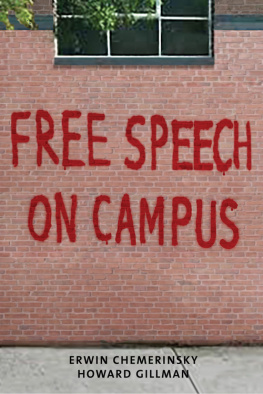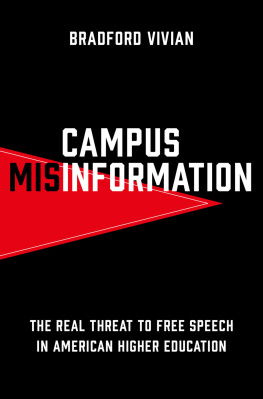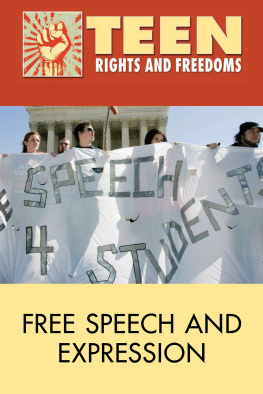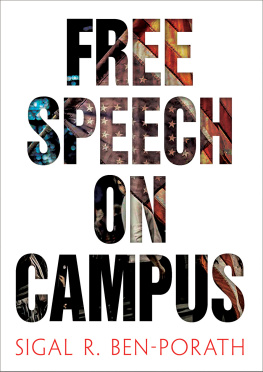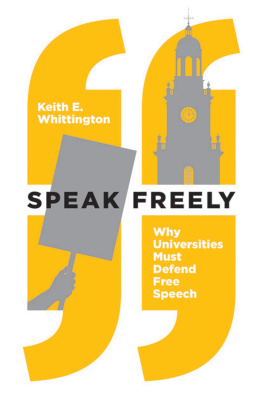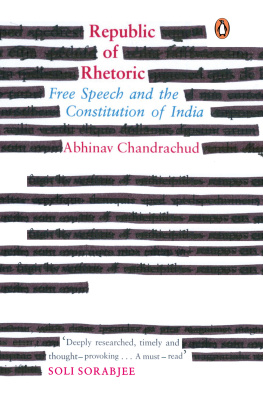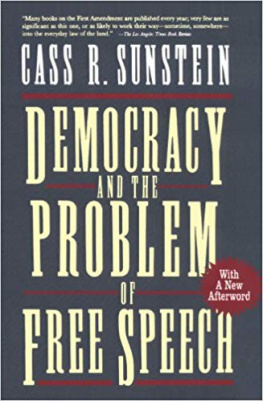FREE SPEECH ON CAMPUS

Copyright 2017 by Erwin Chemerinsky and Howard Gillman.
All rights reserved.
This book may not be reproduced, in whole or in part, including illustrations, in any form (beyond that copying permitted by Sections 107 and 108 of the U.S. Copyright Law and except by reviewers for the public press), without written permission from the publishers.
Yale University Press books may be purchased in quantity for educational, business, or promotional use. For information, please e-mail sales.press@yale.edu (U.S. office) or sales@yaleup.co.uk (U.K. office).
Set in Janson Roman and Monotype Van Dijck types by
IDS Infotech, Ltd.
Printed in the United States of America.
Library of Congress Control Number: 2017934372
ISBN 978-0-300-22656-0 (hardcover : alk. paper)
A catalogue record for this book is available from the British Library.
This paper meets the requirements of ANSI/NISO Z39.481992 (Permanence of Paper).
10 9 8 7 6 5 4 3 2 1
For our students
Contents
Preface
Controversies over freedom of speech on college campuses have existed as long as there have been college campuses. But the specific issues vary with each generation. In recent years the tension has been between the desire to protect the learning experience of all students and the desire to safeguard freedom of expression.
Students are rightly demanding, and colleges and universities are striving to provide, greater diversity and an environment conducive to learning for all students. Often, though, these efforts have led to calls by students and faculty members to restrict, punish, or disrupt speech that is seen as creating a hostile learning environment, especially for those who have traditionally suffered discrimination. Some of this anger has been focused on speech that almost anyone would consider offensive and hateful. But there have also been calls to suppress speech that is merely politically controversial or contrarian. There are demands that campuses deal with microaggressions and require faculty to provide trigger warnings before covering material that some students might find upsetting. Students have demandedand receivedformal investigations of possible violations of federal law after faculty members published scholarly articles in journals. The issues concerning speech on campus are complicated by the unprecedented ability for any person to quickly reach a large audience via social media.
As teachers and university administrators, we have a personal stake in the recent debate concerning freedom of speech on campuses. We fear that discussions over this issue, like so much else in society, are polarizing into two camps. One derides all efforts to protect students from the effects of offensive or disrespectful speech as coddling and political correctness. The other side believes that free speech rights are secondary to the need to protect the learning experience of students, especially minority students.
We wrote this book because we believe that both sides are rightand wrong. They are right in that both equality of educational opportunity and freedom of speech are essential for colleges and universities. But they are wrong in thinking that one of these objectives can be pursued to the exclusion of the other. Colleges and universities must create inclusive learning environments for all students and protect freedom of speech. To achieve both of these goals, campuses may do many things, but they must not treat the expression of ideas as a threat to the learning environment. Freedom of expression and academic freedom are at the very core of the mission of colleges and universities, and limiting the expression of ideas would undermine the very learning environment that is central to higher education.
This book is our effort to describe, as specifically as possible, what campuses can and cant do, and should and shouldnt do, to achieve both of these goals. We recognize, of course, that the First Amendment applies only to public colleges and universities. But academic freedomabove all, the ability to express all ideas and viewpoints, no matter how offensiveis necessary at all colleges and universities. Freedom of expression therefore should be the same at all institutions of higher education. Throughout this book, we rely on First Amendment law in describing what public universities can and cant do. But we draw no distinction between public and private schools when arguing for what they should and shouldnt do.
Our focus is solely on colleges and universities. We realize that similar issues arise in high schools, junior high schools, and even elementary schools. But the Supreme Court has given these schools administrators much more latitude to regulate student speech, and the norms of academic freedom are different, and more central, in higher education.
The issue of free speech on college campuses is as old as universities and as current as the daily news. We have written this book because we believe that colleges must promote inclusive learning environments in a way that also preserves and respects the unfettered expression of ideas on campus. This requires a renewed appreciation of the importance of both values, an explanation of why we should not allow one value to override the other, and a clear path forward for how to advance and defend each of these fundamental features of higher education.
CHAPTER ONE
The New Censorship
W HERE should we draw the line between protecting free speech on college campuses and protecting an inclusive learning environment? Hardly a week goes by without new tensions around this question. Just in the year 2015, for instance, the following events occurred.
In February, George Trey Barnett, a student at the University of Tulsa, was suspended because of statements his husband made on Facebook. Barnetts husband posted criticisms of other students and University of Tulsa staff members who were involved in a theater production with Barnett. After professor Susan Barrett filed a harassment complaint against Barnett because of the postings,
Also in February, Northwestern professor Laura Kipnis wrote an article for the Chronicle of Higher Education titled Sexual Paranoia Strikes Academe, in which she criticized what she called the layers of prohibition and sexual terror that have inspired campus rules prohibiting romantic relationships between professors and students. Kipnis wrote: Its the fiction of the all-powerful professor embedded in the new campus codes that appalls me.... If this is feminism, its feminism hijacked by melodrama. The melodramatic imaginations obsession with helpless victims and powerful predators is whats shaping the conversation of the moment, to the detriment of those whose interests are supposedly being protected, namely students. The result? Students sense of vulnerability is skyrocketing.
In March, members of the Sigma Alpha Epsilon fraternity at the University of Oklahoma were on a bus, dressed in formal wear, going to a fraternity event. Two students led the others in a racist chant:
There will never be a nigger at SAE
There will never be a nigger at SAE
You can hang him from a tree
But hell never sign with me
There never will be a nigger at SAE
President David Boren expelled the two students who led the chant and suspended the fraternity from the campus.
In April, administrators at Youngstown State University ordered the removal of all posters promoting a straight pride week. These posters had been placed on university bulletin boards where all students are allowed to post whatever they please. Jack Fahey, the vice president for student affairs, wrote a memo: As most of you know, an inappropriate flyer announcing Straight Pride Week was posted throughout the campus yesterday. Student
Next page
